- Packaging liquids, pastes, gels, and creams
Properly preparing products that are or contain liquids, pastes, gels, and creams can help ensure that they do not break or leak during the fulfillment process at the Jamboshop hub.
Liquids can cause damage during transportation and storage. To protect buyers, Jamboshop associates, and other products, securely pack liquids, including viscous products like pastes, gels, and creams.
Before you continue reading, gather the following information about the liquid, paste, gel, or cream product you want to sell:
- Is your product classified as a hazardous material?
- Is the container fragile (made of glass) or not?
- Is the container made of glass, and does it hold 100 grams or less?
- Is your product sold in a set or separately?
- Is your product out of date?
Basic drop test requirements
All liquids, pastes, gels, and creams must be able to endure a 3-foot drop test without leaking or spilling their contents. Five 3-foot drops onto a hard surface are used in a drop test:
- Flat on base
- Flat on the longest side
- On a corner
- Flat on the shortest side
- Flat on top
Products regulated as dangerous goods
Dangerous products (also known as hazardous materials or hazmat) are substances or materials that contain combustible, pressurized, corrosive, or otherwise toxic compounds that may pose a risk to health, safety, and environment during the whole shipping process.
The following preparation is required if your product is a liquid, paste, gel, or cream that is classified as a dangerous good — such as perfume, certain bathroom cleaners, polish removers, and permanent ink. Visit Packaging and preparation requirements for further information.
Packaging Requirements for products Regulated as dangerous goods
| Container Type | Container Size | Prep-requirements |
| Non Fragile | Any | Poly-bag |
| Fragile | 100g or more | Poly-bag, bubble wrap, and box |
| Fragile | 100g or less | Poly-bag or bubble wrap |
Packaging Requirements for products not regulated as dangerous goods
| Container Type | Container Size | Prep-requirements | Exceptions |
| Non Fragile | Any | Poly-bag | No bagging is necessary if the liquid is double sealed and passes a drop test. (Examples of double seals can be seen in the table below.) |
| Fragile | 100g or more | bubble wrap | |
| Fragile | 100g or less | No prep required |
Definition of a double seal
A double seal consists of a tightly closed lid that is difficult to open and one of the following:
| · Induction Seal- Thermoplastic material sealed to the opening of a container through induction heating. | 
|
| · Safety Ring- A safety ring is a plastic band that connects a product’s cap to the container. | 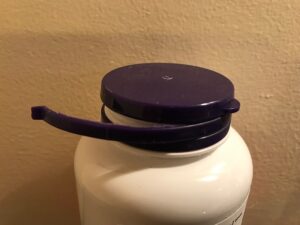
|
| · Clips- Metal clips are used to secure the lid to the can. This rule applies to liquid, paste, gel, and cream items in cans that are not classified as dangerous commodities. Two clips are necessary as a minimum. | 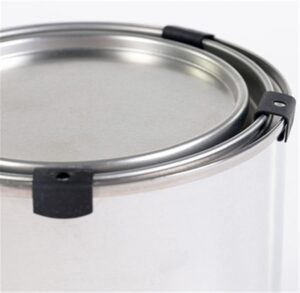 |
| · Plastic wrap band: A tight plastic film that wraps around the product’s opening. |  |
- Packaging pellets, powders, and granular products
Pellets, powders, and granular materials are pourable dry goods that might be damaged during shipping and storage. To safeguard Jamboshop staff, other products, and customers, package these items safely. If the product is packaged in glass, make sure you follow the standards for glass containers. Pellets, powders, and granular material in sets, packages, or bundled products must also meet these specifications.
All items containing pellets, powders, or granular materials must be able to endure a 3-foot (91.4 cm) drop test without leaking or spilling their contents.
Polybags must be used to package products that cannot withstand the drop test.
- Packaging glass-ceramic breakable and fragile products
Here you can discover how to properly prepare breakable or delicate products so that they are not damaged throughout the fulfillment process.
Packaging guidelines
| Do… | Don’t… |
| · To avoid damage, individually wrap or box each unit. Each wine glass in a set of four, for example, must be wrapped individually.
· Fragile units should be packed with six solid sides to ensure that they are not exposed in any way. · Wrap several Units separately to prevent them from causing damage to one another while in transit. · Check that your boxed units can withstand a 3-foot drop to a hard surface without breaking. |
· Don’t leave empty space in the package, which may reduce the likelihood of the product passing the 3-foot drop test. |
Recommended cushioning materials:
| a) Bubble Wrap | 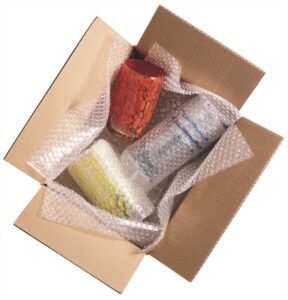 |
| b) Air pillows/ cushion |  |
| c) Paper/Manila | 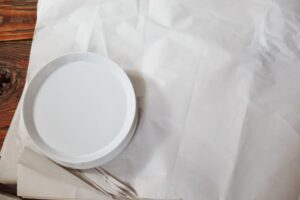 |
- Packaging batteries
This section will guide you how to properly prepare batteries so that they remain safe during the fulfillment process.
Dry batteries must be packaged appropriately in order to be stored and shipped securely. To avoid battery connections coming into contact with metals, make sure the batteries are securely fastened within the container (including other batteries). Batteries must not be expired or damaged, and expiration dates must be evident on the packaging if supplied in packs. Batteries supplied in packs and multi-pack sets of batteries are included in these packaging requirements.
Permitted packaging materials (rigid packaging):
- Original manufacturer packaging
- Boxes
- Clamshell plastic
Packaging materials that are prohibited (unless when used in conjunction with rigid packaging that is permitted):
- Zipper-sealed bags
- Shrinkwrap
Packaging Guidelines
| Do… | Do Not… |
| · Check to see if packaged batteries can withstand a 4-foot drop onto a hard surface without breaking. | · Ship batteries that may fall loose in or out of the box
· Ship batteries terminals may come into touch with each other. · Ship Batteries that are simply held together by zippered bags, shrink wrap, or another non-rigid packaging |
| · Ensure that repackaged batteries are tightly packed in boxes or clamshell packaging.
No further boxing or sealing of batteries is necessary if multi-pack batteries are sealed in original manufacturer packaging. If the batteries are to be repackaged, they must be put in sealed boxes or sealed hard plastic clamshell packaging. |
Definition of rigid packaging
One or more of the following are examples of rigid battery packaging:
- Original clamshell plastic or blister pack packaging from the manufacturer.
- Batteries that have been repackaged and sealed in boxes that have been taped or shrink-wrapped shut. Batteries must not be able to roll around in the boxes, and the battery terminals must not come into contact with one another.
- Batteries that have been repackaged in clamshell plastic that has been taped or shrink-wrapped shut. The battery terminals must not come into contact with each other within the packaging.
- Packaging Plush Units
Plush package Stuffed toys, animals, and puppets are packaged in such a way that they are not damaged during the reception, stocking, shipping preparation, or shipment to the consumer. Units must be shrink-wrapped or sealed in a polybag.
Packaging guidelines
| Do… | Don’t… |
| · Place plush Units in clear sealed bags or shrink-wrap (minimum 1.5 mil) with a suffocation warning sign plainly visible.
· To avoid damage, make sure the entire plush unit is enclosed (no exposed surfaces). |
· Allow the bag or shrink-wrap to protrude more than 3 inches beyond the product’s dimensions.
· Send a product with the plush Unit exposed inside. |
Examples of prepped units

From the figure above, we can easily see what is permitted and what is not.
Not Allowed: The Unit is exposed to dust, dirt, and damage.
Allowed: The Unit is enclosed in a polybag that does not expose the product to dust, dirt, and damage.
- Packaging sharp units
On this page, you’ll discover how to protect products with exposed sharp edges during the fulfillment process by properly preparing them.
Sharp units have a sharp or pointed edge that, when exposed, poses a safety danger to Jamboshop employees and customers. Sharp units must be wrapped or over-boxed such that the sharp or pointed edge does not come into contact with the customer during receiving, stocking, shipment preparation, or delivery.
Packaging guidelines
| Do… | Don’t… |
| · Make certain that the sharp object is completely covered by the packaging.
· When possible, use blister packs. The blister pack must cover the sharp edge and be securely fastened to the Unit so that it does not move within the blister pack. · Wrap the sharp Unit in plastic if possible and secure it to a footprint with a plastic fastener or similar restraint. · Make sure the Unit can’t cut through the packaging. |
· Pack dangerous products in plastic-wrapped molded footprints.
· Pack sharp products with only cardboard or plastic sheaths unless the sheath is made of a rigid, durable plastic and is securely fastened to the product. |
Packaging materials allowed:
- Bubble wrap (unit cannot cut through)
- Boxes (unit cannot cut through)
- Dunnage
- Labels
Examples of prepped Units


Allowed Not Allowed
- Packaging Small Products
On this page, you’ll discover how to safeguard products smaller than a credit card from dust and damage during the fulfillment process by properly preparing them.
To prevent the Unit from being misplaced or lost, any product with the largest side less than 2-1/8″ (the width of a credit card) must be wrapped in a polybag with the barcode on the outside of the bag. During the fulfillment process, this will also safeguard the device from tearing, dirt, dust, or liquid damage. Because some products are too small to have a label, bagging the unit allows the barcode to be fully scannable without wrapping around the product’s borders.
Packaging Guidelines
| Do… | Don’t… |
| · Small units should be packaged in clear sealed bags (minimum of 1.5 mil.). Suffocation warning labels must be clearly visible on poly bags with a 5″ opening or greater. Plastic bags, for example, can be hazardous. Keep this bag away from newborns and children to avoid suffocation.
· Place a product description label with a barcode on the side with the most surface area. |
· Force a product into a bag that is too tiny. This is not a good idea.
· Allow the bag to protrude more than 3 inches beyond the product’s measurements. · Pack small units in black bags · Pack small units in bags that are much larger than the unit itself. |
- Packaging adult products
Adult items must be packaged in black, opaque bags for protection. A readable SKU and a suffocation warning must be on the outside of the bag. This contains products that fulfill any of the following criteria, but is not limited to:
- Products that include images of naked models in their natural state
- Messages that are indecent or offensive on the packaging
- Items that are lifelike in nature but lack the nuance of a real model
Acceptable adult product packaging
- Tame, abstract products that are not life‐like in nature
- Plain packaging without models
- Plain packaging where models are not in suggestive or compromising positions
- Packaging with no obscene text
- Suggestive text but no profanity
- Packaging small gifts and Jewelry
Any jewelry unit that may be damaged throughout the fulfillment process due to tearing, dirt, dust, or liquid must be packaged according to these standards. During the fulfillment process, jewelry must be packaged in such a way that the unit cannot be destroyed or harmful conditions created by having the material exposed.
Pouches
- To avoid dust damage, pouches must be packed individually in plastic bags with the barcode on the exterior of the pouch. A product description label should be placed on the side with the most surface area.
- The bag should be large enough to hold a pouch. Don’t stuff a pouch into a bag that’s too tiny for it or put it in a bag where it’ll move about. Large bags’ edges are more likely to catch and tear, exposing the contents to dust and grime.
- A “suffocation warning” must be included on poly bags with a 5″ aperture or bigger (minimum 1.5 mil). “Plastic bags, for example, can be hazardous.” Keep this bag away from newborns and children to avoid suffocation.”
- All poly bags must be transparent.
Examples of pouches that have been correctly wrapped, one per bag, with a readable SKU/barcode inside the bag for dust protection. The pouches are slightly bigger than the bags.

Boxed Jewelry
- Sleeves are not required for boxes made of easily cleaned materials. Dust protection is provided via sleeves.
- Boxes constructed of fabric-like material that is prone to dust or ripping must be bagged or packaged separately, with the barcode prominently displayed.
- Only slightly larger than the device, the protective sleeve or bag should be used.
- The SKU/barcode must be visible with the sleeve in place, and the box sleeves should be snug enough or held in such a way that they do not slide off.
- If possible, labels should be connected to the box; if fastened properly, they can be attached to sleeves.
A fabric-like box is correctly stored in a bag that is somewhat larger than the box in this example. This has been well-packaged.
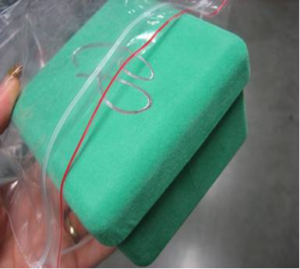
This illustration shows a box that is poorly covered by an unsecured sleeve, allowing the box to slip out and become detached from the sleeve and barcode. This has been packaged incorrectly.

- Packaging apparel, fabric, and textiles
Dust and humidity can harm cloth, fabric, and textiles. These items must be wrapped to avoid damage during receiving, storage, shipping preparation, and delivery to the consumer. Fill a sealed poly bag, shrink wrap, or box with the units. Typically, regular-size hangers must be removed.
Packaging guidelines
| Do… | Don’t… |
| · Individual units of fabric or textile garments, as well as any cardboard backings, should be placed in transparent, sealed bags or shrink-wrap (minimum of 1.5 mils) conspicuously marked with a suffocation warning label.
· To fit in the package, fold items to the lowest size possible. · Fold all clothing neatly to its smallest dimensions and place it in a bag or box that fits perfectly. Make sure there are no creases or breaks in the packaging. · For materials like leather that could be harmed by bags or shrink wrap, use boxes. · After bagging, make sure each product has a visible readable label. · No material should be exposed while packaging footwear. |
· Allow the bag or shrink-wrap to extend beyond the product’s dimensions by more than 3 inches.
· Regular-size hangers should be avoided. · Send in unmatched singles or groups of shoes. · Use packaging for footwear other than the original manufacturer-provided box. |
Examples of prepped units
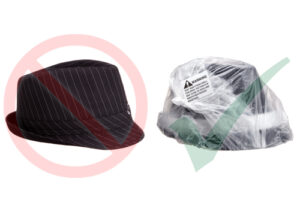
From the figure above, we can easily see what is permitted and what is not.
Not Allowed: The product has been subjected to dust, dirt, and damage.
Allowed: The item is sealed in a polybag with a suffocation warning label.


